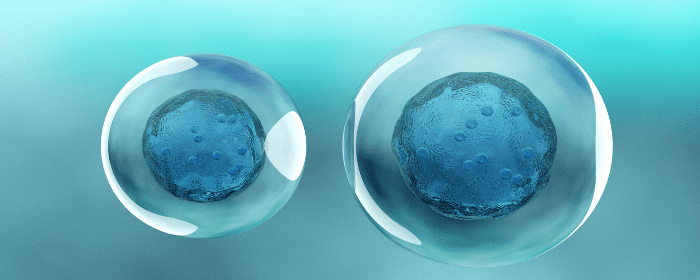
by admin | Jan 17, 2024 | Exosomes, Glaucoma, Regenerative Medicine, Stem Cell Research, Stem Cell Therapy
According to the World Health Organization, at least 2.2 billion people worldwide have near or distant vision impairment. In at least 1 billion of these cases, vision impairment could have been prevented or has yet to be addressed. Glaucoma, corneal disease, and retinal disorders are among the leading contributors to these vision impairments.
Since the pathogenesis of these eye diseases is not fully understood, fully effective treatments have yet to be developed. Considering this, Li et al. reviewed recent research to examine the effectiveness of exosomes in various diseases in vivo, which provides the potential for a new option for the treatment of eye diseases.
Exosomes are extracellular small vesicles that are formed by the regulation of endocytosis, fusion, and efflux and contain a variety of biologically active substances, including proteins, miRNAs, IncRNAs, and lipids.
Exosomes are found in all biological fluids and have roles that vary depending on their origin. These roles include cell-to-cell communication, waste transfer, and regulation of the immune system in vivo. Additionally, when serving as a carrier, exosomes are involved in many pathological processes such as nerve repair, vascular regeneration, immune response, and fibrosis formation.
Examining the various roles exosomes play within the body, the authors of this review consider their role in the treatment of serious ocular diseases, including glaucoma, diabetic retinopathy, and keratitis. Li et al. point to studies demonstrating exosomes’ ability to promote the repair of injured nerves, inhibit fibrosis, modulate immune function, and promote angiogenesis as evidence of the important role they have in treating ocular disease.
Specifically, exosomes contain a large number of immunosuppressive molecules that inhibit lymphocyte proliferation and effectively increase ocular immune tolerance to prevent ocular autoimmune disease.
Exosomes can also transfer protein and RNA to receptor cells and can accelerate wound healing of corneal epithelial cells, providing a new approach for treating large corneal lesions.
Studies have also demonstrated a link between exosomes and age-related macular degeneration (AMD) with specific exosomes considered to have neuroprotective effects that are closely related to the pathological progression of AMD.
The authors conclude that exosomes are able to be used as therapeutic carriers to participate in processes such as immune response, angiogenesis, and nerve repair in ocular-related diseases. While research into this is still emerging, the presence and accessibility of exosomes will become a potential way to diagnose and treat ocular diseases.
Source: “Progress in exosomes and their potential use in ocular diseases.” 18 Sep. 2020, https://www.ncbi.nlm.nih.gov/pmc/articles/PMC7459212/.

by admin | Jun 18, 2021 | Stem Cell Research, Glaucoma, Stem Cell Therapy
Characterized by vision loss caused by progressive damage to the optical nerve, glaucoma continues to be the second leading cause of blindness worldwide. Although painless, the glaucoma-induced cupping, thinning, and structural damage caused to various parts of the eye causes vision loss that starts in the periphery and gradually travels inward, eventually resulting in a total loss of vision.
Current treatments for glaucoma are mainly pharmacologic, laser-based, and surgical procedures that reduce the eye’s intraocular pressure (IOP), the most treatable risk factor of glaucoma. While these treatments have been demonstrated to be effective in treating the symptoms associated with glaucoma, they are not able to restore vision that has already been lost as a result of glaucoma.
The purpose of Chamiling et al.’s review is to evaluate the current developments surrounding the use and effectiveness of stem cell therapy, not only to treat the symptoms of glaucoma and other optic neuropathic conditions but also to explore the potential of restoring vision loss resulting from these conditions.
According to the authors, while most glaucoma-based therapies center around controlling IOP, they fail to address the main contributing factors associated with glaucoma-associated vision loss – which include axonal damage and loss of retinal ganglion cells (RGCs), the neurons that make up the optical nerve and that are responsible for transmitting visual images from the eye to the brain.
In their natural state, RGCs are what’s considered postmitotic; in other words, they are cells that do not regenerate. This means that any vision loss sustained as a result of the loss of these RGCs is permanent and unable to be reversed. Adding to the severity of early glaucoma is the fact that significant damage to, and loss of, RGCs typically occur before the first signs of developing visual issues are detected.
However, with the recent advancements in cell-based therapies, and considering the field’s rapid-developing understanding of ocular regeneration, there is hope that science will soon be able to advance options that not only treat glaucoma but also restore vision lost as a result of the condition. As such, Chamiling et al. focus this review primarily on the use of stem cell-derived RGCs for drug discovery and transplantation-based therapy in four specific areas: control of intraocular pressure; using pluripotent stem cells as a source of RGCs; stem cell-derived RGCs for transplantation and vision restoration; and using stem cell as a source for neurotrophic factors (NTF).
Through their review of the literature and, in part, a summary of advanced discussions held at the 2015 Ocular Research Symposia Foundation’s “Sight Restoration Through Stem Cell Therapy” meeting, the authors conclude that advancements in our understanding of stem cells combined with key advancements made in the field of ocular biology have resulted in the ability to differentiate human stem cells into a number of different ocular cell types.
While much of the research and trials examined has involved animal models of study, the progression of these efforts has led to a number of human trials exploring the differentiation of stem cells into retinal pigment epithelial cells. In addition, and more specifically related to glaucoma, recent studies demonstrate significant potential for the differentiation of stem cells into trabecular meshwork (TM) and RGCs as well as the opportunity to be used as a way to secrete NTFs.
As a result of this review, Chamling et al. call for continued study into the potential of human stem cells for the treatment of glaucoma while also concluding that the rapid advancement in stem cell technology continues to provide the pathway to further understanding of stem-cell applications in this field and to offer new hope for using cell-based therapies as a way to restore vision lost as a result of glaucoma or other optic nerve conditions.
Source: (2016, April 1). The Potential of Human Stem Cells for the Study … – PubMed – NIH, from https://pubmed.ncbi.nlm.nih.gov/27116666/

by admin | Apr 23, 2021 | Glaucoma, Stem Cell Research, Stem Cell Therapy
Glaucoma is a group of eye conditions that damage the optic nerve and lead to progressive, irreversible loss of vision. With over 80 million people affected by the condition, glaucoma is the second-leading cause of blindness, behind only age-related macular degeneration.
Although there are several different risk factors, the most understood and treatable risk factor for glaucoma involves controlling the eye’s intraocular pressure, or IOP. When left unaddressed, glaucoma progressively leads to vision loss resulting from damage to axons and associated retinal ganglion cells (RGCs) responsible for transmitting visual information from the eye to the brain. While current treatments for glaucoma are primarily pharmacologic, laser-based, and surgical procedures designed to lower and/or control IOP, they are unable to reverse or restore vision lost as a result of previous damage to the affected axons, RGCs, and the collective optic nerve.
Chanling, Slush, and Zack’s article aim to assess current literature and developments exploring the potential of using human stem cells to further study, and potentially treat, glaucoma and other conditions affecting the optic nerve. For the purposes of this review, the authors divide their discussion into four key areas: stem cell-derived trabecular meshwork cells to control IOP; stem cells as a source of RGCs; stem cell-derived RGCs for transplantation and vision restoration; and stem cells as a source for neurotrophic factors.
Stem Cell-Derived Trabecular Meshwork Cells to Control IOP
Insufficient drainage of the eye’s aqueous humor results in increasing IOP. Current medication for the treatment of this condition reduces aqueous production and or increases aqueous outflow through the trabecular meshwork (TM). Since the TM is a known source of stem cells, researchers hypothesize that these cells and specifically mesenchymal stem cells (MSCs) could be used to repair IOP function and potentially restore vision lost as a result of this condition.
Recent studies have shown promising results, leading researchers to believe that there is a strong possibility of using stem cell-derived TM cells to preserve optic nerve function and reduce IOP.
Stem cells as a Source of RCGs
In addition to assisting with regulating IOP, researchers believe that stem cells may also be able to preserve, and even restore, RCG function – which is ultimately responsible for vision loss caused by glaucoma.
Specifically, the authors point to a number of animal studies that have demonstrated positive responses in a number of signaling pathways and neuroprotective compounds responsible for promoting RNC function and survival. The authors also point out that, while these studies are promising, none have made it to the clinic.
Stem Cell-Derived RGCs for Transplantation and Vision Restoration
While still a relatively new concept, there has been tremendous progress made in the ability to transplant RCEs and photoreceptor cells in the eye. Coupled with the observed differentiation of RGCs, researchers believe the ability to successfully transplant RGCs, with the intent of restoring glaucoma-related vision loss, is not far off.
The authors note that, while these findings are promising, there is still much work and additional research to be completed in this area and that the process of transplanting RCGs is much more complicated than the process used for transplanting retinal pigment epithelial cells (RPEs) and photoreceptors cells.
Stem Cells as a Source for Neurotrophic Factors (NTFs)
Research suggests that deprivation of the NTF required for maintenance and survival of neurons is a leading factor in the progression of glaucoma. As a result, additional research has reported that supplementing additional BDNF and other NTFs, through the use of stem cells appears to support the health and survival of RGC. The authors point out that, while promising, the process required during this procedure is challenging, primarily because it requires the blood-retinal barrier to be circumvented.
The authors of this review conclude that, as a result of the rapidly advancing pace of ocular stem cell research and related ongoing advancements in stem cell technology, there are ongoing opportunities to better understand and improve upon the current glaucoma-related biology and to develop pharmacological models that include cell-based therapies in the effort to restore vision to those affected by glaucoma.
Source: (n.d.). The Potential of Human Stem Cells for the Study and … – IOVS from https://iovs.arvojournals.org/article.aspx?articleid=2518375

by admin | Feb 12, 2021 | Glaucoma, Mesenchymal Stem Cells, Stem Cell Therapy
Glaucoma is a complex group of interrelated eye conditions that affects over 70 million people worldwide. A leading cause of irreversible blindness in people over 60, glaucoma is a progressive condition that affects the optic nerve and leads to gradual loss of specific neurons that relay visual information from the retina to the brain; the progressive vision loss caused by glaucoma is often associated with increased pressure in the eyes[1].
Currently, pharmaceutical and surgical treatment for glaucoma focus on relieving pressure in the eye by treating the trabecular meshwork (TM), the part of the eye that relieves pressure by allowing drainage of the aqueous humor. Unfortunately, to date, these treatment options have demonstrated only to delay, not correct, or prevent, the progression of glaucoma. Additionally, these treatment options are not effective in repopulating or regenerating the retinal ganglion cells (RGCs), the neurons that relay visual information to the brain; in other words, these treatments have proven largely ineffective in patients with advanced stages of glaucoma.
With the advances made in stem cell therapy, and especially considering the functional properties of mesenchymal stem cells (MSCs), several new therapeutic approaches to treating glaucoma-related issues are currently being considered.
In this review article, Harrell et. al drew key observations from the information presented in over 250 journal articles to assess the current knowledge and future perspectives when considering the beneficial effects of MSCs in the treatment of glaucoma.
Specifically, researchers have found that the neurotrophins produced by MSCs encourage both the survival and regeneration of RGCs affected by glaucoma; MSCs appear to support RGCs by generating cells that are similar to RGCs and through promoting the expansion and differentiation of retinal stem cells (RSCs) in RGCs. MSCs are also believed to support the integrity of TM cells, allowing for pressure in the eyes to be reduced.
After reviewing the abstracts of 253 journal articles on the topic, the authors of this review concluded that the large number of studies examining MSCs’ ability to treat and/or protect the eye from the harmful effects of glaucoma was primarily dependent on MSCs capacity to provide neuroprotection for, and support regeneration in, RGCs.
However, as the authors point out, while several of these studies appear to demonstrate the potential benefits of MSCs and their secretome in glaucoma therapy, neither the safety nor efficacy have been validated in clinical settings or clinical trials with the appropriate number of enrolled patients.
While there appear to be several beneficial effects associated with using MSCs and their secretome in glaucoma therapy in humans, the authors conclude that these claims can only be verified if MSC-dependent therapeutic effects are confirmed through future clinical trials.
Source: (n.d.). Therapeutic Potential of Mesenchymal Stem Cells and … – Hindawi from https://www.hindawi.com/journals/sci/2019/7869130/
[1] “Glaucoma – Symptoms and causes – Mayo Clinic.” 23 Oct. 2020, https://www.mayoclinic.org/diseases-conditions/glaucoma/symptoms-causes/syc-20372839.





 St. Petersburg, Florida
St. Petersburg, Florida
